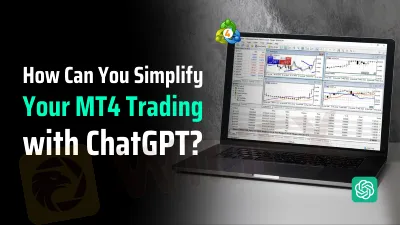简体中文
繁體中文
English
Pусский
日本語
ภาษาไทย
Tiếng Việt
Bahasa Indonesia
Español
हिन्दी
Filippiiniläinen
Français
Deutsch
Português
Türkçe
한국어
العربية
How Can You Simplify Your MT4 Trading with ChatGPT?
Abstract:Learn how ChatGPT can help you create trading bots and indicators for MetaTrader 4 (MT4). Discover easy steps to code and optimize your trading strategies.

MetaTrader 4 (MT4) is one of the most popular forex trading platforms, known for its powerful capabilities and exceptional versatility. It offers a wide range of tools that allow traders to automate their trading systems, thereby reducing the time spent on manual trading and preventing rash decisions that could lead to losses. With the advent of artificial intelligence (AI), a frequently asked question in trading circles is whether ChatGPT can generate code for the MT4 interface. The answer is yes but with some limitations. This article explores how ChatGPT can assist with MT4 code authoring and identifies areas that still require optimization and customization.
Understanding ChatGPT
ChatGPT, developed by OpenAI, is a deep-learning language model designed to generate human-like text responses based on the input it receives. This functionality is extremely useful for scripting in MT4, enabling the creation of scripts, indicators, Expert Advisors (EAs), and other automated trading tools. ChatGPT allows users to obtain code snippets relevant to their trading strategies by providing well-defined instructions. This not only simplifies the development process but also makes it accessible to individuals without extensive programming knowledge.
Steps to Generate a Trading Bot for MT4 with ChatGPT
Creating a trading bot for MT4 using ChatGPT involves several critical steps:
1. Collect Market Data: The first step in constructing a ChatGPT-based trading bot is to gather extensive market data from previous years related to the targeted trading assets or strategies. This historical data is crucial as it helps in training the model, allowing it to recognize key market patterns and behaviors.
2. Train the Model: Given the complexity of the trading process, it is essential to adjust the model according to specific goals and trading tendencies. Proper training ensures that the model can generate effective and reliable trading strategies that align with your objectives.
3. Code the Trading Robot: Once the model is adequately trained, the next step is to code the trading robot. This involves incorporating all necessary logic and algorithms for real-time trading, processing market data, and interacting with ChatGPT. Effective coding is vital to ensure that the trading robot operates reliably and produces consistent results.
4. Link to External Services: Connecting the trading bot to external services such as databases or APIs is crucial for accessing the latest market data and executing trades in real time. This ensures that the bot has up-to-date information and can respond to market changes swiftly.
5. Test and Deploy: After writing the code, it is important to thoroughly test the trading bot before deploying it in a live trading environment. Testing helps identify any potential issues or bugs and ensures that the bot's performance meets the required standards.
Creating Code Snippets using ChatGPT
Users can generate MQL4 code snippets by using enhanced prompts that provide detailed explanations. For instance, if you want a basic moving average crossover strategy, you can describe it explicitly to ChatGPT, and it will generate the necessary MQL4 code. The accuracy of your description directly impacts the relevance and quality of the resulting code.
Creating Custom MT4 Indicators
If you require a specific indicator that is not available in the standard MT4 library, ChatGPT can assist in writing the code based on your specifications. By carefully defining the logic and functionality of the desired indicator, you can leverage ChatGPT's capabilities to create custom tools that meet your trading needs.
Create Expert Advisors (EAs)
ChatGPT can also help in developing Expert Advisors (EAs), which are fully automated trading robots that can execute buy or sell positions without human intervention. This feature is particularly useful for developing complex trading strategies that require immediate decision-making.

Steps to Use ChatGPT for MT4 Code
1. Define Your Strategy: Clearly outline your preferred trading strategy or indicator. The level of detail you provide will determine the quality and accuracy of the output.
2. Input Prompts to ChatGPT: Be specific with your prompts. For example, when describing a moving averages crossover strategy, specify the type of moving averages, their periods, the signals to buy or sell, and stop-loss levels.
3. Review and Test the Code: After receiving the generated code from ChatGPT, review it for any errors or inconsistencies. Test the code in a demo trading account before using it for live trading to ensure it performs as expected.
Can a Trading Bot Make a Profit?
Trading bots have the potential to be profitable, but their performance heavily depends on the effectiveness of the trading strategy, market conditions, and ongoing monitoring and adjustments. While ChatGPT can assist with coding and strategy creation, traders must remain vigilant and responsive to changing market conditions.
Is it Difficult to Build an MT4 Trading Bot?
Building a trading bot involves many processes that require a combination of technical expertise and strategic thinking. Although ChatGPT can help streamline the code-writing process, challenges may arise during testing and deployment. The complexity of the process, the need for updates, and thorough testing make building a reliable trading bot a challenging task.
Tips for Using ChatGPT to Generate Trading Robots
· Clarity and Specificity: Provide precise instructions to avoid confusion and achieve the best results. Detailed descriptions of your trading strategy and goals will yield more relevant and accurate code.
· Test and Refine: Validate the generated code by back-testing it with historical data. Repeated testing helps identify defects and make necessary improvements to enhance performance.
· Migrate to an MT4 Trading Platform: Ensure your trading bot is compatible with the chosen platform. Tools like TradingView or Pine Script can facilitate strategy implementation and management.
· Monitor and Adjust: Regularly monitor your bot's performance and adjust its strategy and parameters as market conditions change to maintain optimal performance.
· Leverage Multiple MT4 Indicators: Enhance your trading strategy by combining different technical signals, such as RSI with moving averages or Bollinger Bands, for more accurate decision-making.
· Consider Market Sentiment: Incorporate market sentiment analysis to manage risk and make more informed decisions. This approach can help your bot operate effectively in unpredictable market conditions.
Conclusion
ChatGPT can significantly simplify the process of coding for MetaTrader 4. By following the steps and tips outlined above, traders can create effective trading bots, custom indicators, and Expert Advisors, thereby enhancing their trading efficiency and decision-making processes. However, continuous testing, monitoring, and adjustments are crucial to ensure optimal performance in a real market environment.
Disclaimer
This information is not considered investment advice or a recommendation but rather a marketing communication aimed at providing insights into the potential uses of ChatGPT for MT4 coding. Always perform thorough testing and consult with a financial advisor before deploying any automated trading systems.

Disclaimer:
The views in this article only represent the author's personal views, and do not constitute investment advice on this platform. This platform does not guarantee the accuracy, completeness and timeliness of the information in the article, and will not be liable for any loss caused by the use of or reliance on the information in the article.
Read more

WikiFX Review: Something You Need to Know About MIFX
WikiFX created a comprehensive review to help you better understand this broker named MIFX. We will analyze its reliability based on specific information, regulations, etc. Let’s get into it.

Philippine Banks Launch PHPX Stablecoin for Cross-Border Payments
Philippine banks collaborate to launch PHPX, a peso-backed stablecoin, revolutionizing cross-border payments with real-time transfers and financial inclusion goals.

The Yuan’s Struggle: How China Plans to Protect Its Economy
China introduced new measures on Monday to support its weakening currency, the yuan, amidst mounting economic and political pressures. The government announced plans to boost foreign exchange reserves in Hong Kong and ease borrowing restrictions for companies to improve capital flows.

XTB Secures UAE and Indonesia Licenses, Expands in 2025
XTB accelerates global growth in 2025 by securing key licenses in the UAE and Indonesia, paving the way for broader services and innovative offerings worldwide.
WikiFX Broker
Latest News
Wolf Capital Exposed: The $9.4M Crypto Ponzi Scheme that Lured Thousands with False Promises
Confirmed! US December non-farm payroll exceeded expectations
Spain plans 100% tax for homes bought by non-EU residents
90 Days, Rs.1800 Cr. Saved! MHA Reveals
The Yuan’s Struggle: How China Plans to Protect Its Economy
LiteForex Celebrates Its 20th Anniversary with a $1,000,000 Challenge
Misleading Bond Sales Practices: BMO Capital Markets Fined Again by SEC
Italy’s Largest Bank Intesa Sanpaolo Enters Cryptocurrency Market
What Every Trader Must Know in a Turbulent Market
400 Foreign Nationals Arrested in Crypto Scam Raid in Manila
Currency Calculator







